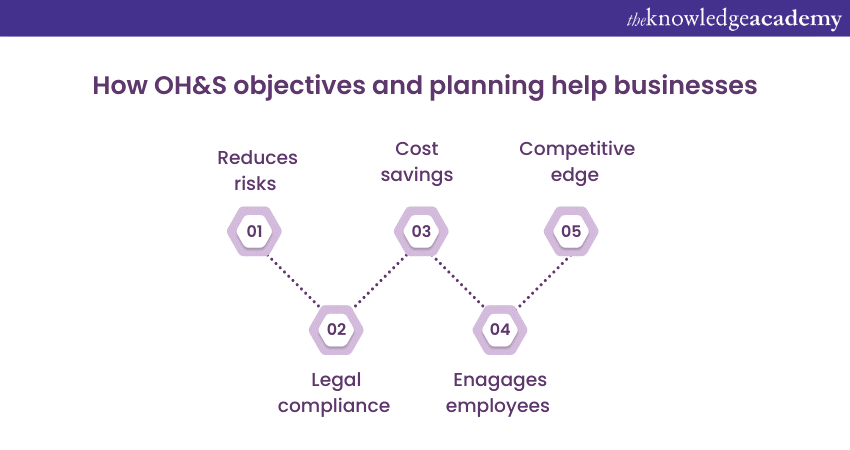We may not have the course you’re looking for. If you enquire or give us a call on +44 1344 203 999 and speak to our training experts, we may still be able to help with your training requirements.
Training Outcomes Within Your Budget!
We ensure quality, budget-alignment, and timely delivery by our expert instructors.

Implementing effective Occupational Health and Safety (OH&S) measures is crucial to creating a secure work environment. ISO 45001 is a globally accepted standard for OH&S management systems and provides a framework for organisations to establish and achieve ISO 45001 Objectives and plans.
According to HSE, 6 million working days were lost in the UK alone because of work-related injuries. Having OH&S objectives and planning to mitigate such incidents and risks is essential. In this blog, you will learn about the ISO 45001 Objectives and plans and how they can improve your company's performance.
Table of Contents
1) What are ISO 45001 Objectives and Plans?
2) Occupational health and safety objectives
3) Planning to achieve OH&S objectives
4) How do OH&S Objectives and planning help businesses?
5) Conclusion
What are ISO 45001 Objectives and plans?
ISO 45001 defines objectives as the overall goals an organisation sets itself to achieve in relation to OH&S performance. Objectives serve as a roadmap for organisations to continuously improve their OH&S management systems and ensure the well-being of their employees.
On the other hand, plans outline the specific actions and steps an organisation will take to achieve its OH&S objectives. These objectives and plans are essential components of a proactive and systematic approach to occupational health and safety management.
Occupational health and safety objectives
In ISO 45001, establishing OH&S objectives is an important step in ensuring the effectiveness of an organisation's occupational health and safety management system. These objectives provide a clear direction and purpose for the organisation to strive towards improving its OH&S performance. Based on Clause 6.2.1 of ISO 45001, these are the key considerations for setting OH&S objectives.
1) Relevance: They must address the organisation's specific OH&S needs and challenges.
2) Measurability: They should be measurable to assess progress and promote continuous improvement.
3) Achievability: They should be realistic and attainable based on available resources.
4) Timeframe: It should have a defined timeframe for accomplishment.
5) Integration: Objectives should align with the organisation's overall business goals.
6) Consultation and Participation: Involving workers and stakeholders in an objective setting promotes engagement and ownership.
7) Evaluation and Review: They should be periodically evaluated and adjusted based on performance and changes.
8) Here are some ISO 45001 Objectives examples:
a) Reduce the number of workplace accidents and incidents by X% over the next year.
b) Implement a comprehensive safety training program to ensure all employees receive proper training in X number of months.
c) Achieve X% reduction in occupational illnesses through effective hazard identification and control measures.
Learn all the necessary knowledge to implement the occupational health and safety management system at your workplace with our comprehensive ISO 45001 Training courses.
Planning to achieve OH&S objectives
By considering these elements during the planning process, organisations can effectively implement actions to achieve their OH&S objectives, leading to improved occupational health and safety performance. Clause 6.2.2 of ISO 45001 emphasises the importance of planning to achieve OH&S objectives. It outlines key steps that organisations should undertake in their planning process:
1) Actions: Define specific actions to control hazards, mitigate risks, and improve occupational health and safety.
2) Resource requirements: Assess the resources needed for implementing planned actions, including human, financial, and technological resources.
3) Responsibility assignment: Assign roles and responsibilities to individuals or teams for the effective execution of OH&S plans.
4) Timeline: Establish timeframes for completing actions to ensure progress towards objectives is measurable and timely.
5) Evaluation and monitoring: Establish indicators to evaluate results and effectiveness of actions, allowing for ongoing assessment of performance.
6) Integration with business processes: Integrate OH&S actions into the organisation's overall business processes for seamless alignment and decision-making.
Become an ISO 45001 Internal Auditor and ensure your organisation's safety with ISO 45001 Internal Auditor training.
How do OH&S Objectives and planning help businesses?
Using occupational health and safety (OH&S) objectives and planning improves business performance in the following ways.

1) Risk reduction: Mitigating workplace hazards reduces accidents, injuries, and illnesses, increasing productivity and employee well-being.
2) Compliance: Following OH&S objectives ensures legal and regulatory compliance, minimising fines, penalties, and reputational damage.
3) Cost savings: Effective planning reduces costs associated with medical expenses, compensation claims, and productivity losses due to accidents and injuries.
4) Employee engagement: Prioritising employee health and safety fosters engagement, loyalty, and teamwork, reducing turnover and attracting top talent.
5) Productivity boost: A safe work environment enhances well-being, reducing work-related illnesses, injuries, and stress, resulting in increased productivity.
6) Reputation enhancement: Demonstrating a strong commitment to OH&S improves reputation, building trust and loyalty among customers and stakeholders.
7) Competitive advantage: Integration of OH&S objectives differentiates businesses, attracting customers who value safety and responsible practices.
Conclusion
Incorporating ISO 45001 Objectives and planning based on clause 6 is vital for businesses. It enhances workplace safety, ensures compliance, reduces risks, improves performance, and fosters employee engagement. It also brings cost savings, enhances reputation, and provides a competitive edge. By prioritising OH&S, businesses create a culture of safety, protect their workforce, and contribute to long-term success and sustainability. Embracing OH&S objectives and planning is a legal obligation and an ethical responsibility that benefits employees and the overall business.
Learn how to improve your organisation's occupational health and safety (OH&S) management systems with ISO 45001 Foundation training.
Frequently Asked Questions
Upcoming Health & Safety Resources Batches & Dates
Date
 ISO 45001 Foundation
ISO 45001 Foundation
Mon 10th Feb 2025
Mon 19th May 2025
Mon 8th Sep 2025
Mon 8th Dec 2025







 Top Rated Course
Top Rated Course



 If you wish to make any changes to your course, please
If you wish to make any changes to your course, please


